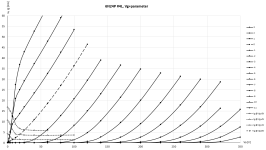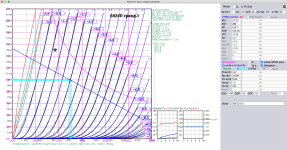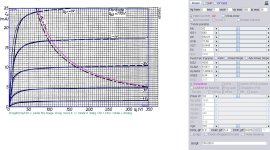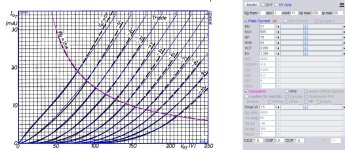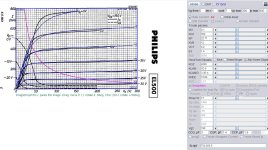Is the Russian 6N24P equivalent to PCC89, except for heater voltage?
I've wondered if a variable-mu triode would make a good second stage in a guitar preamp. Drive it hard to get some compression effects but stay subjectively 'clean' (no obvious clipping or 'fuzz' tone).
The same can be done with a small signal pentode, but a vari-mu triode might be easier to work with to get the desired result... maybe?
I've wondered if a variable-mu triode would make a good second stage in a guitar preamp. Drive it hard to get some compression effects but stay subjectively 'clean' (no obvious clipping or 'fuzz' tone).
The same can be done with a small signal pentode, but a vari-mu triode might be easier to work with to get the desired result... maybe?
FYI - the 6N24P is NOT a variable mu / remote cut-off triode like the PCC89.
I have done measurements to clarify exactly this question.
BR Adrian
I have done measurements to clarify exactly this question.
BR Adrian
Thanks for the info on 6N24P. Someone once wrote on diyAudio that a 6N24P he had looked like it had the identical internal structure to an Electro Harmonix 6922 (probably a 6N23P), but with a different pinout. Could it be that the 6N24P is basically a 6N23P with a different pinout?
Is there a reasonably good spice model for 6N24P available? I can't seem to find one thru a Google search...
Is there a reasonably good spice model for 6N24P available? I can't seem to find one thru a Google search...
I can confirm that one of the two different 6N24P constructions is electrically identical to the 6922EH construction. Hence, why not just use an 6922EH model for a 6N24P sim.
"Foreign analogue of lamp 6H24P: ECC89, 6FC7. Источник: https://eandc.ru/catalog/6n24p/"
https://radiolamp.net/news/908-analogi-importnyh-i-otechestvennyh-radiolamp-spravochnik.html
"6N24P - ECC89, 6FC7
Sources:
You have to measure one and find out what it matches.
https://radiolamp.net/news/908-analogi-importnyh-i-otechestvennyh-radiolamp-spravochnik.html
"6N24P - ECC89, 6FC7
Sources:
- Yegor Voznesensky - Imported lamps and their analogues, 1998.
- Analogues of the USSR (fuzzy.ncport.ru)."
You have to measure one and find out what it matches.
Pinout are identical of 6N24P and ECC89, but not the grid construction - only the ECC89 has a variable mu grid
I can't find a datasheet for ECC89 in the Frank Phillipse database site. I'm not sure what that is, exactly.
From looking at the datasheets, 6ES8 looks like ECC189, which I understand is different from ECC89.
The only datasheet I could find for 6CF7 has no plate curves, so I can't tell if it's 100% equivalent to an ECC189 or 6ES8.
If Adrian measured some 6N24Ps and found them to have even grid construction and typically constant mu, then 6N24P is not a variable-mu triode and therefore is not equivalent to ECC189 or 6ES8.
And remember, we don't know exactly what the ECC89 is. Insufficient data.
So I'm completely lost with this one.
I have a box of 6N24P I bought long ago, and maybe they'll be as linear as a 6DJ8 for audio circuits. That would be nice.
From looking at the datasheets, 6ES8 looks like ECC189, which I understand is different from ECC89.
The only datasheet I could find for 6CF7 has no plate curves, so I can't tell if it's 100% equivalent to an ECC189 or 6ES8.
If Adrian measured some 6N24Ps and found them to have even grid construction and typically constant mu, then 6N24P is not a variable-mu triode and therefore is not equivalent to ECC189 or 6ES8.
And remember, we don't know exactly what the ECC89 is. Insufficient data.
So I'm completely lost with this one.
I have a box of 6N24P I bought long ago, and maybe they'll be as linear as a 6DJ8 for audio circuits. That would be nice.
... the 6N24P is VERY linear. And its characteristics underestimated/missunderstood, therefore super cheap.
Some Amp Creators may hesitate to use it because of the shield connected to one grid. But this just means adding 4pF from Grid to environment. So, as long as the very first stage (and the reverb amplifier) is done with the other triode, you will not notice any difference to a 6922EH.
So, the 6N24P is - with big margin - favorite tube!
BR Adrian
Some Amp Creators may hesitate to use it because of the shield connected to one grid. But this just means adding 4pF from Grid to environment. So, as long as the very first stage (and the reverb amplifier) is done with the other triode, you will not notice any difference to a 6922EH.
So, the 6N24P is - with big margin - favorite tube!
BR Adrian
Attachments
Hi
I found some 6N24P spice model on my HD
from measurements
https://klausmobile.narod.ru/testerfiles/6n24p.htm
.
I found some 6N24P spice model on my HD
from measurements
https://klausmobile.narod.ru/testerfiles/6n24p.htm
.
Code:
*
**** 6N24P ******************************************
* Created on 08/06/2024 00:29 using paint_kit.jar 3.1
* www.dmitrynizh.com/tubeparams_image.htm
* Plate Curves image file:
* Data source link: Measured chrs
*----------------------------------------------------------------------------------
.SUBCKT 6N24P 1 2 3 ; Plate Grid Cathode
+ PARAMS: CCG=1.55P CGP=1.6P CCP=1.5P RGI=2000
+ MU=37.75 KG1=268 KP=235.7 KVB=155.04 VCT=-0.15 EX=1.4
*----------------------------------------------------------------------------------
* Vp_MAX=300 Ip_MAX=22 Vg_step=0.5 Vg_start=1 Vg_count=22
* Rp=23500 Vg_ac=0.08 P_max=1.8 Vg_qui=-2 Vp_qui=125
* X_MIN=77 Y_MIN=33 X_SIZE=835 Y_SIZE=783 FSZ_X=1727 FSZ_Y=907 XYGrid=true
* showLoadLine=y showIp=y isDHT=n isPP=n isAsymPP=n showDissipLimit=y
* showIg1=n gridLevel2=n isInputSnapped=n
* XYProjections=y harmonicPlot=y dissipPlot=y
*----------------------------------------------------------------------------------
E1 7 0 VALUE={V(1,3)/KP*LOG(1+EXP(KP*(1/MU+(VCT+V(2,3))/SQRT(KVB+V(1,3)*V(1,3)))))}
RE1 7 0 1G ; TO AVOID FLOATING NODES
G1 1 3 VALUE={(PWR(V(7),EX)+PWRS(V(7),EX))/KG1}
RCP 1 3 1G ; TO AVOID FLOATING NODES
C1 2 3 {CCG} ; CATHODE-GRID
C2 2 1 {CGP} ; GRID=PLATE
C3 1 3 {CCP} ; CATHODE-PLATE
D3 5 3 DX ; POSITIVE GRID CURRENT
R1 2 5 {RGI} ; POSITIVE GRID CURRENT
.MODEL DX D(IS=1N RS=1 CJO=10PF TT=1N)
.ENDS 6N24P
*$Attachments
A lot of those sites show , for example, 6N1P as a 6922 analog, which it is not. I only trust the original datasheet, in Russian. The original datasheet does not mention "variable mu", and the mu curve shows that it is pretty stable across different operating points."Foreign analogue of lamp 6H24P: ECC89, 6FC7. Источник: https://eandc.ru/catalog/6n24p/"
https://radiolamp.net/news/908-analogi-importnyh-i-otechestvennyh-radiolamp-spravochnik.html
"6N24P - ECC89, 6FC7
Sources:
The soviets probably knew better what they were copying. 😏
- Yegor Voznesensky - Imported lamps and their analogues, 1998.
- Analogues of the USSR (fuzzy.ncport.ru)."
You have to measure one and find out what it matches.
ECC89 & ECC189 datasheetsI can't find a datasheet for ECC89 in the Frank Phillipse database site. I'm not sure what that is, exactly.
Attachments
Thank you for this! I should have thought to search for PCC89 instead of just ECC89.
Yes, you can clearly see in the plate curves that ECC89 is variable mu (and very variable at that!).
Compare to 6N24P, which has plate curves that do not show variable mu.

Now watch the price of 6N24P shoot up... ugh.
Yes, you can clearly see in the plate curves that ECC89 is variable mu (and very variable at that!).
Compare to 6N24P, which has plate curves that do not show variable mu.
Now watch the price of 6N24P shoot up... ugh.
Rough calculation: 50 tubes =One tube = 10 to 20 years of service life with normal use50 x 20 Years = 1000 yearsThis much surplus is good. It's always better to have too many Tubes than too few.....!!!
It's just a shame that Humans only live to a maximum of 100 years... 1,000 Years would be a good age...But everything Humans have invented... all the Patents... you have to write it down on PAPER, otherwise almost everything gets lost..Like the Bible, you have to save it !!! .Or save it on hard drives, on RAID, and copy it every 20 Years... everything Humanity has invented is so Bad that we ourselves are ALIENS..
Russ. Piston 6N24P also seems to be really Good....
But about PCC 89 and PCC189 are not better than PCC88.PCC88 is same as ECC88 with less Distortion🙂🙂🙂🙂🙂😎😎😎😉😉😉
Gruss Chris
It's just a shame that Humans only live to a maximum of 100 years... 1,000 Years would be a good age...But everything Humans have invented... all the Patents... you have to write it down on PAPER, otherwise almost everything gets lost..Like the Bible, you have to save it !!! .Or save it on hard drives, on RAID, and copy it every 20 Years... everything Humanity has invented is so Bad that we ourselves are ALIENS..
Russ. Piston 6N24P also seems to be really Good....
But about PCC 89 and PCC189 are not better than PCC88.PCC88 is same as ECC88 with less Distortion🙂🙂🙂🙂🙂😎😎😎😉😉😉
Gruss Chris
Last edited:
PCF80 SPICE MODELS.
PENTODE:
TRIODE:
PENTODE:
Code:
**** PCF80 ******************************************
* Created on 04/26/2025 13:08 using paint_kip.jar
* www.dmitrynizh.com/tubeparams_image.htm
* Plate Curves image file: PCF80_170.jpg
* Data source link: <plate curves URL>
*----------------------------------------------------------------------------------
.SUBCKT PCF80 P G2 G K ; LTSpice tetrode.asy pinout
* .SUBCKT PCF80_170 P G K G2 ; Koren Pentode Pspice pinout
+ PARAMS: MU=42 KG1=880 KP=252.27 KVB=11.88 VCT=0.0445 EX=1.4 KG2=4200 KNEE=6.84 KVC=2.57
+ KLAM=5.5E-7 KLAMG=7.406E-6 KNK=-0.044 KNG=0.006
+ CCG=5.2P CGP=3.4P CCP=0.025P RGI=2000.0
* Vp_MAX=350 Ip_MAX=25 Vg_step=1 Vg_start=0 Vg_count=5
* X_MIN=54 Y_MIN=44 X_SIZE=683 Y_SIZE=484 FSZ_X=1351 FSZ_Y=790 XYGrid=false
* Rp=1400 Vg_ac=20 P_max=1.8 Vg_qui=-2 Vp_qui=300
* showLoadLine=n showIp=y isDHP=n isPP=n isAsymPP=n isUL=n showDissipLimit=y
* showIg1=n isInputSnapped=y addLocalNFB=n
* XYProjections=n harmonicPlot=y dissipPlot=n
* UL=0.43 EG2=170 gridLevel2=n addKink=n isTanhKnee=n advSigmoid=n
*----------------------------------------------------------------------------------
RE1 7 0 1G ; DUMMY SO NODE 7 HAS 2 CONNECTIONS
E1 7 0 VALUE= ; E1 BREAKS UP LONG EQUATION FOR G1.
+{V(G2,K)/KP*LOG(1+EXP((1/MU+(VCT+V(G,K))/SQRT(KVB+V(G2,K)*V(G2,K)))*KP))}
RE2 6 0 1G ; DUMMY SO NODE 6 HAS 2 CONNECTIONS
E2 6 0 VALUE={(PWR(V(7),EX)+PWRS(V(7),EX))} ; Kg1 times KIT current
G1 P K VALUE={V(6)/KG1*ATAN(V(P,K)/KNEE)*(1+KLAMG*V(P,K))+KLAM*V(P,K)}
* Alexander Gurskii screen current, see audioXpress 2/2011
RE4K 4K K 1G ; Dummy, per Alex request
E4K 4K 4 VALUE={0} ; Dummy, per Alex request
G4K 4K K VALUE={V(6)/KG2*(KVC-ATAN(V(P,K)/KNEE))/(1+KLAMG*V(P,K))}
RCP P K 1G ; FOR CONVERGENCE
C1 K G {CCG} ; CATHODE-GRID 1
C2 G P {CGP} ; GRID 1-PLATE
C3 K P {CCP} ; CATHODE-PLATE
R1 G 5 {RGI} ; FOR GRID CURRENT
D3 5 K DX ; FOR GRID CURRENT }
.MODEL DX D(IS=1N RS=1 CJO=10PF TT=1N)
.ENDSTRIODE:
Code:
**** PCF80_T ******************************************
* Created on 04/26/2025 16:04 using paint_kit.jar 3.1
* www.dmitrynizh.com/tubeparams_image.htm
* Plate Curves image file: PCF80_T.jpg
* Data source link:
*----------------------------------------------------------------------------------
.SUBCKT TRIODE_PCF80_T 1 2 3 ; Plate Grid Cathode
+ PARAMS: CCG=1.8P CGP=2.5P CCP=1.5P RGI=2000
+ MU=21 KG1=885 KP=78 KVB=84 VCT=0.956 EX=1.386
* Vp_MAX=250 Ip_MAX=35 Vg_step=1 Vg_start=0 Vg_count=11
* Rp=4000 Vg_ac=55 P_max=1.5 Vg_qui=-48 Vp_qui=300
* X_MIN=80 Y_MIN=43 X_SIZE=731 Y_SIZE=512 FSZ_X=1360 FSZ_Y=641 XYGrid=false
* showLoadLine=n showIp=y isDHT=n isPP=n isAsymPP=n showDissipLimit=y
* showIg1=n gridLevel2=n isInputSnapped=n
* XYProjections=n harmonicPlot=n dissipPlot=n
*----------------------------------------------------------------------------------
E1 7 0 VALUE={V(1,3)/KP*LOG(1+EXP(KP*(1/MU+(VCT+V(2,3))/SQRT(KVB+V(1,3)*V(1,3)))))}
RE1 7 0 1G ; TO AVOID FLOATING NODES
G1 1 3 VALUE={(PWR(V(7),EX)+PWRS(V(7),EX))/KG1}
RCP 1 3 1G ; TO AVOID FLOATING NODES
C1 2 3 {CCG} ; CATHODE-GRID
C2 2 1 {CGP} ; GRID=PLATE
C3 1 3 {CCP} ; CATHODE-PLATE
D3 5 3 DX ; POSITIVE GRID CURRENT
R1 2 5 {RGI} ; POSITIVE GRID CURRENT
.MODEL DX D(IS=1N RS=1 CJO=10PF TT=1N)
.ENDSAttachments
EL500 SPICE Models.
Code:
**** EL500 ******************************************
* Created on 04/26/2025 18:58 using paint_kip.jar
* www.dmitrynizh.com/tubeparams_image.htm
* Plate Curves image file: EL500_190.jpg
* Data source link: <plate curves URL>
*----------------------------------------------------------------------------------
.SUBCKT EL500 P G2 G K ; LTSpice tetrode.asy pinout
* .SUBCKT EL500_190 P G K G2 ; Koren Pentode Pspice pinout
+ PARAMS: MU=8.1 KG1=352 KP=22.71 KVB=12 VCT=0.2 EX=1.4 KG2=4200 KNEE=15.84 KVC=2.57
+ KLAM=1E-6 KLAMG=3.3E-4 KD=0.5016 KC=0.2674 KR1=9.1E-5 KR2=0.0736 KVBG=0.0132 KB1=1.98 KB2=1.62 KB3=2.04 KB4=0.54 KVBGI=8.9E-4 KNK=-0.044 KNG=0.006
+ CCG=3P CGP=1.4P CCP=1.9P RGI=2000.0
* Vp_MAX=300 Ip_MAX=800 Vg_step=5 Vg_start=0 Vg_count=7
* X_MIN=80 Y_MIN=39 X_SIZE=590 Y_SIZE=391 FSZ_X=1329 FSZ_Y=779 XYGrid=false
* Rp=1400 Vg_ac=20 P_max=17 Vg_qui=-15 Vp_qui=300
* showLoadLine=n showIp=y isDHP=n isPP=n isAsymPP=n isUL=n showDissipLimit=y
* showIg1=n isInputSnapped=y addLocalNFB=n
* XYProjections=n harmonicPlot=y dissipPlot=n
* UL=0.43 EG2=190 gridLevel2=n addKink=n isTanhKnee=n advSigmoid=y
*----------------------------------------------------------------------------------
RE1 7 0 1G ; DUMMY SO NODE 7 HAS 2 CONNECTIONS
E1 7 0 VALUE= ; E1 BREAKS UP LONG EQUATION FOR G1.
+{V(G2,K)/KP*LOG(1+EXP((1/MU+(VCT+V(G,K))/SQRT(KVB+V(G2,K)*V(G2,K)))*KP))}
RE2 6 0 1G ; DUMMY SO NODE 6 HAS 2 CONNECTIONS
E2 6 0 VALUE={(PWR(V(7),EX)+PWRS(V(7),EX))} ; Kg1 times KIT current
E4 8 0 VALUE={V(P,K)/KNEE/(KVBGI+V(6)*KVBG)}
E5 81 0 VALUE={PWR(V(8),KB1)}
E6 82 0 VALUE={PWR(V(8),KB2)}
E7 83 0 VALUE={PWR(V(8),KB3)}
E8 9 0 VALUE={PWR(1-EXP(-V(81)*(KC+KR1*V(82))/(KD+KR2*V(83))),KB4)*1.5708}
RE4 8 0 1
RE5 81 0 1
RE6 82 0 1
RE7 83 0 1
RE8 9 0 1
G1 P K VALUE={V(6)/KG1*V(9)*(1+KLAMG*V(P,K))+KLAM*V(P,K)}
G2 G2 K VALUE={V(6)/KG2*(KVC-V(9))/(1+KLAMG*V(P,K))}
RCP P K 1G ; FOR CONVERGENCE
C1 K G {CCG} ; CATHODE-GRID 1
C2 G P {CGP} ; GRID 1-PLATE
C3 K P {CCP} ; CATHODE-PLATE
R1 G 5 {RGI} ; FOR GRID CURRENT
D3 5 K DX ; FOR GRID CURRENT }
.MODEL DX D(IS=1N RS=1 CJO=10PF TT=1N)
.ENDS
*$
* The following triode model is derived from pentode model, see above.
* In the triode model, all spice parameters come directly from the pentode model, except for Kg1,
* which for triode-strapped pentodes is derived from pentode's Kg1, Kg2 and Kvc as
*
* 4Kg1Kg2 / ((2Kvc-Pi)(2Kg1+PiKg2))
**** EL500******************************************
* Created on 04/26/2025 18:58 using paint_kit.jar 4.7
* www.dmitrynizh.com/tubeparams_image.htm
* Plate Curves image file: EL500_190.jpg
* Data source link: <plate curves URL>
*----------------------------------------------------------------------------------
.SUBCKT TRIODE_EL500 1 2 3 ; Plate Grid Cathode
+ PARAMS: CCG=3P CGP=1.4P CCP=1.9P RGI=2000
+ MU=8.1 KG1=212.91 KP=22.71 KVB=12 VCT=0.2 EX=1.4
* Vp_MAX=300 Ip_MAX=800 Vg_step=5 Vg_start=0 Vg_count=7
* Rp=1400 Vg_ac=20 P_max=17 Vg_qui=-15 Vp_qui=300
* X_MIN=80 Y_MIN=39 X_SIZE=590 Y_SIZE=391 FSZ_X=1329 FSZ_Y=779 XYGrid=false
* showLoadLine=n showIp=y isDHT=n isPP=n isAsymPP=n showDissipLimit=y
* showIg1=n gridLevel2=n isInputSnapped=y
* XYProjections=n harmonicPlot=y dissipPlot=n
*----------------------------------------------------------------------------------
E1 7 0 VALUE={V(1,3)/KP*LOG(1+EXP(KP*(1/MU+(VCT+V(2,3))/SQRT(KVB+V(1,3)*V(1,3)))))}
RE1 7 0 1G ; TO AVOID FLOATING NODES
G1 1 3 VALUE={(PWR(V(7),EX)+PWRS(V(7),EX))/KG1}
RCP 1 3 1G ; TO AVOID FLOATING NODES
C1 2 3 {CCG} ; CATHODE-GRID
C2 2 1 {CGP} ; GRID=PLATE
C3 1 3 {CCP} ; CATHODE-PLATE
D3 5 3 DX ; POSITIVE GRID CURRENT
R1 2 5 {RGI} ; POSITIVE GRID CURRENT
.MODEL DX D(IS=1N RS=1 CJO=10PF TT=1N)
.ENDS
*$Attachments
Last edited:
- Home
- Amplifiers
- Tubes / Valves
- Vacuum Tube SPICE Models
